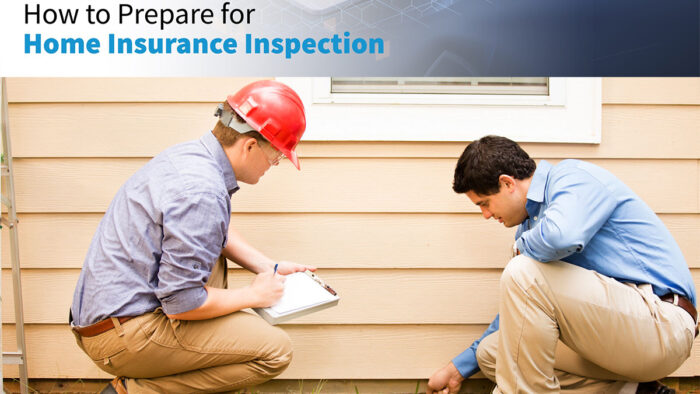Home insurance inspections vary from identifying expired and damaged electrical systems or wrong wiring, water damage, cracks on the walls, and the years in which the home has been in existence. All of these inspections provide the agents or the insurance provider with the necessary information to help determine the level of coverage required on the property. If you are wondering how to prepare for a home insurance inspection, then this article will explain to you all you need to know about home insurance inspections.

What is Home Insurance Inspection?
Just like every other standard home inspection, a home insurance inspection assesses the condition of the policyholder’s properties. A home insurance inspection evaluates your home’s replacement cost and makes sure that the cost is in accordance with the insurance company’s initial estimate.
A home insurance inspection guides the insurers to understand the risks involved in covering your house. It also allows your insurer to decipher how much it would cost to rebuild your house and to spot any issues, like weak structures, years of existence, and wrong wiring. These information are needed to help them decide how good the shape of your house is and how much the premium should cost.
How to Prepare for a Home Insurance Inspection
A thorough check of your home is very necessary before the home insurance inspection to avoid potential shortcomings or dangers. All the damaged places have to be repaired and put back together before the arrival of the insurance inspectors. Preparing for a home insurance inspection takes two forms, which are the interior and exterior parts.
But before preparing for the home insurance inspection, there are some things that you need to have in hand before the inspection begins. Some of the things that you need before the inspectors come include:
- Your receipts for any renovations that you have made to the house.
- You must have clear and pronounced documentation of the square footage of your home.
- Videos and photos of the properties in the home will be needed.
- Your details on the alarm system are also required.
Preparing for the interior part includes:
- If there are any fireflies in the room, make sure you clean them up properly.
- Check your smoke detectors to see if they are working properly. Make sure to fix it if there are any issues with it.
- Scrutinize your home’s fire extinguisher to make sure it’s functioning properly. It is the major thing that will be checked when the inspector comes.
- Look out for doors and windows on your inside to look for damage from termites or rain.
- Check below your sinks, faucets, toilets, taps, and showerhead for signs of leaks.
- Lastly, scout your walls to look for cracks.
Before an internal inspection is carried out by the insurance inspectors, make sure all of these are scanned through properly to ensure that there won’t be issues when the inspector comes.
To prepare for the exterior part of the house, follow the steps below;
- Check the sidling doors and windows to see if there are anything like leaks or signs of damage to them by water.
- Search for any potential hazards that you think could cause injury to someone on the property.
- Make sure you check for and trim any overhanging branches or dead limbs that could pose a hazard to the roof of the home.
- Clean your gutters, if you have any, and check if they are secured to the home properly.
- Examine any fractures or cracks in the foundation to see whether they are weaker.
What Does a Home Insurance Inspector Look For?
Essentially, a home insurance inspector inspects your homes to look out for potential indicators that might increase your chance of filing a claim or what could lead to an injury to your property. These are the things a home insurance inspector looks out for:
- Faulty ventilation system
- Water damages or decay pipes
- Cracks in the building structures
- Rodent or insect invasion
- years of the building’s existence
- Recent renovations
- Working condition of the smoke detectors or carbon monoxide.
- Areas prone to natural disasters.
- Conditions of your basement.
- Flooring
- Compliance with pool safety measures.
All of these inspections are to consider if your home is in good maintenance condition and to see if there are liability risks present within the dwelling and property. Some insurance home inspectors might not require the presence of the home owner. But this kind of inspection is often done for the exterior parts of the house.
What Happens After a Home Insurance Inspection?
After all inspections have been carried out by the home insurance inspectors, all the data collected, observations made, notes taken, summaries, checklists, videos, and photographs will be used to create considerable reports. Then all complete assessments of the condition of your home and its system will be extensively reported.
The report will then be taken to the homeowners insurance company, where it will be reviewed to determine whether you’ve passed or failed the inspection. If, for instance, you pass the insurance, you will get a new policy with good terms. And if you already have a policy with them, it will remain effective. But if the inspection goes wrong, you can ask for a copy of the report and then proceed to improve your home.
A home insurance inspection is available to identify potential safety issues, find discounts, and, most importantly, make sure to check for ways to increase your safety. Therefore, providing your inspector with vital information about your renovations, security systems, and square footage is very essential.
Benefits of a Home Insurance Inspection
There are several specific benefits that come with a home insurance inspection. These benefits include:
An inspection informs customers about which sections of their house require safety precautions and rapid attention. It also improves the health, well-being, and safety of you and your loved ones.
How to Make One’s Way in a Home Insurance Inspection
How to make one’s way in a home insurance inspection simply means how to pass the inspection. The surest way to pass an inspection is by completing routine home maintenance and fixing any issues that you notice in your home, like cracked walls or a leaky roof, to minimize damage to your home.
Another way is to always let your insurance agent know when you plan to make changes to your property or home. Changes such as the construction of a new structure in the home, renovations, and the decision to add a swimming pool or trampoline.
FAQS
Is it Compulsory to Get a Home Insurance Inspection?
It’s not mandatory to get a home insurance inspection. It all depends on the insurance company you work with. Most insurance companies will not require you to complete a home insurance inspection before allowing coverage, most especially when the building of the house is new or an inspection has been carried out there recently. Most inspections happen after the building has been in place for a number of years.
Must Home Insurance Inspectors Take a Picture and Video of My House?
One of the responsibilities of these inspectors is to record and take pictures during the inspection process.
Photos are taken to prove that the problems exist and to know if a problem has been corrected.
What Happens If You Fail a Home Insurance Inspection?
No one is above mistakes, but when these mistakes occur, there is room for correction. If your inspectors find issues with your home, they may give you a deadline to fix them to ensure continuity of coverage. But for some, if it’s beyond repair, they might cancel the policy.
Can I Get Home Insurance Without a Home Inspection?
Yes, you can get home insurance without a home inspection. It all depends on your insurance provider and if your house is a newer home.



